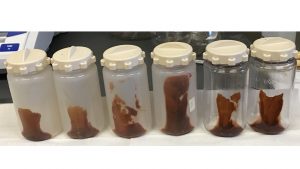Hello, I am AnnElise Hardy, a biomedical engineer at Northwestern University, ‘19, and I am working with Elena Rozhkova in the Nanoscience and Technologies Division as part of the larger Artificial Neuron Group led by Chris Fry. The group is working towards creating an artificial neuron, a bio-inspired assembly. The proposed design will place light activated transmembrane proton pumps either taken from the archaea Halobacterium halobium, or created synthetically, on a gold compartmentalized structure in order to create an assembly that can mimic the low-voltage ion flow of a neuron. These “protocells” are the first step in creating an artificial neuron to then be used in neuromorphic computing systems.
Currently, I am working to isolate the proton pumps, each attempt takes a few days and a couple more days to grow more archaea. Our first few attempts were not successful, but we are adapting our procedure to address what we think the problems are. For example, we have increased the amount we distress the cells in order to break up the membranes more. If we cannot achieve isolation directly from the archaea, we will then move to create the pumps in a cell-free synthesis, which Dr. Rozhkova has shown here. The benefit of cell-free synthesis lies in the removal of time- and labor-intensive culturing of the archaea, limiting the issues we have seen in harvesting the pumps at the optimal point of cell growth.
